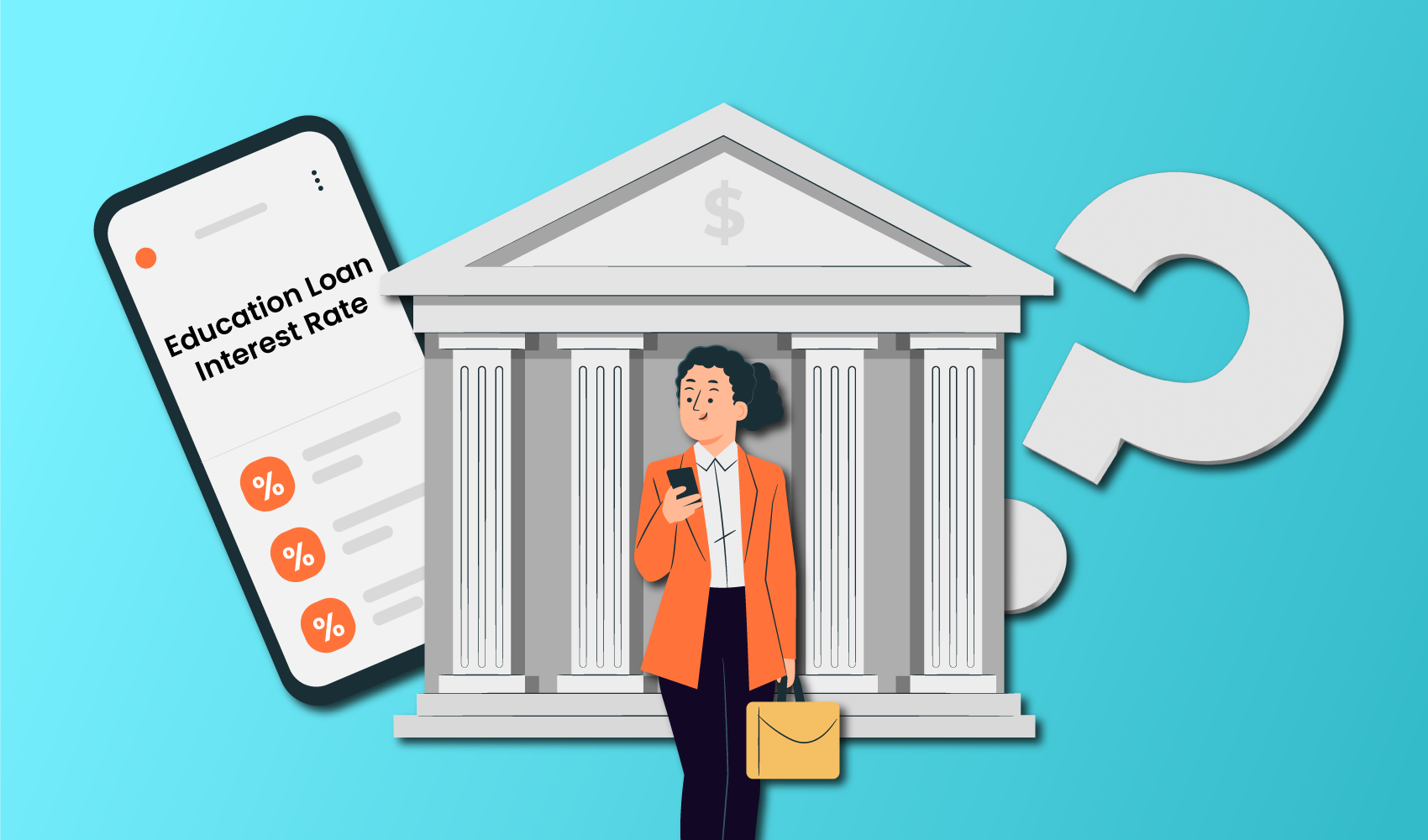The rate of interest is what tips the scales for most students.
This isn’t randomly chosen. Banks analyze a number of factors ranging from the economic conditions to your credit score to come up with the education loan interest rates.
Education loans are one of the riskiest loans for banks. Students tend to default the most on repayment. This is why there is an intensive pre-approval check.
But if you need your loan approved urgently, then FundRight’s services can help you with that. This one-stop solution gives you all the tools you need to decide on the right financing option.
Making an informed choice is crucial. That’s why you should read on.
What factors influence education loan interest rates?
Student’s Profile
The financing organization will look at your educational history.
They will look at your scores in the 10th and 12th board examinations.
And if you’re applying to a master’s program, they will need your UG scorecard as well.
If you were working, then your salary during the employment period will also be considered.
Guarantor’s Profile
In case you cannot repay the loan, the bank needs a backup. So typically, an earning person can be your guarantor. Even if you were employed, a guarantor is needed. Their bank statements, salary slip, and credit score are all scrutinized.
MCLR
Full form: Marginal Cost of Funds Based Lending Rate
This is the rate of interest below which banks cannot lend loans. This was introduced to negate any chance of unfair interest rates being granted to the bank’s prime customers.
The MCLR system was introduced in 2016. The rate changes monthly. So the rate of interest could still change per borrower.
The RBI can make exceptions to the MCLR rules. So you may be able to secure education loans at lower interest rates.
Here are the current MCLR rates for some lenders (April 2022).
| Banks | 6 Months | 1 Year | 3 Years | Base Rate |
| SBI Bank | 6.95% | 7.0% | 7.30% | 7.55% |
| ICICI Bank | 7.20% | 7.25% | NA | 8.85% |
| IDBI Bank | 7.45% | 7.80% | 8.60% | 9.65% |
| IOB | 7.40% | 7.45% | 7.45% | 9.45% |
| Axis Bank | 7.35% | 7.40% | 7.55% | 9.15% |
| Canara Bank | 7.30% | 7.35% | NA | 9.40% |
| Union Bank of India | 7.05% | 7.25% | 7.30% | 8.40% |
| Punjab and Sind Bank | 7.55% | 7.65% | NA | 9.70% |
| Bank of Baroda | 7.25% | 7.40% | NA | 8.15% |
| HDFC Bank | 7.05% | 7.20% | 7.40% | 9.30% |
| South Indian Bank | 7.90% | 8.15% | NA | 9.75% |
Course and Institution
This is how the bank’s loan disbursement officer thinks.
If you’re attending an A-Rank institution, then your employment opportunity is likely to be better. This means you are more likely to pay back the loan without defaults. So the interest rate will likely decrease.
Likewise, the bank will also take the course into consideration. STEM graduates tend to be higher paid than Arts majors. So the banks will favor giving education loans for studies abroad to STEM majors.
Collaterals
You need to arrange collateral for loans above a certain amount. If you’re unable to repay the loan, the banks will seize the collateral to repay themselves. In fact, Indian banks have always faced the problem of substantial NPAs in the education loans segment. Here’s some data from the pre-pandemic years. This gives them a guarantee that they will be paid back either way. So they’re likely to decrease the student loan interest rate if the collateral is submitted.
For non-collateral loans, NBFCs, private banks, and international lenders are your best options. Private student loan interest rates are typically higher because there is no collateral given to the organization. However, this isn’t always true.
Find out more on collateral versus non-collateral loans.
On FundRight, you can get a loan without collateral, that too at the lowest interest rate in the market. This means you save lakhs. And this isn’t all. FundRight is just one part of our suite of digital enablers for Indian students looking to study abroad.
NBFCs have their own set of rules when it comes to deciding the education loan interest rates. They look at the country you’re traveling to on top of the course and personal information.
What are the types of student loan interest rates?
When you visit a bank’s website, you’ll see an advertised rate of interest. Most banks don’t usually give education loans at this interest rate. They’ll assess you on the criteria above and give you a new rate of interest.
And here’s another curveball for you – there are various types of interest rates. Let’s discuss.
What is Fixed Interest Rate?
As the name suggests, this type of interest rate will remain the same throughout your repayment period. Changes in the market or economic conditions won’t affect the interest rate. This is a safe option. At the same time, there is no possibility for the interest rate to decrease, as there is with floating interest.
What is Floating Interest Rate?
This is an ever-changing type of student loan interest rate. The rate depends on the changes in the market conditions.
Sometimes, the RBI encourages lending by giving banks a lot of money. This will result in a decrease in the interest rates.
Financial strains in the country will lead to banks increasing their interest rates. The basis for the fluctuation is the base rate.
Going for financial support with a floating interest rate is a gamble that sometimes pays off.
When should you opt for a floating interest rate?
For education loans abroad, it makes sense to choose floating interest rates only if the repayment term is long. Most banks offer a repayment period between 10-15 years.
Why? Because the rates don’t drop or increase drastically. The rates are usually revised yearly or half-yearly. This is called the reset period and it’s decided by the bank.
So if it increases in year 1, there’s a chance it could decrease in year 3. This all depends on the market. But if you’re planning to repay the loan within year 3, then you may not reap the benefits of lower rates of interest.
However, for long-term repayment plans, you can be fairly certain that the total interest rate would decrease.
How to make a decision?
When applying for an education loan for studies abroad, you’ll need to consider a host of factors. To make the research easy for you, we’ve collated the information you’ll need.
Here are the rates of interest and other terms offered by some NBFCs and banks.
| Organization Name | Interest Rate | Type of Interest Rate | Collateral for Study Abroad | Processing Fees | Maximum Loan Tenure | Pre-Visa Distribution | Extent of Cover | Loan Holiday | Pre-sClosure Charges |
| Auxilo | 11% – 14% | Floating | Collateral and Non-Collateral available | 1% of loan amount | 10 years | Depending on the country | 100% | 6 months – 1 year after completion | As per RBI guidelines |
| Avanse | 11.5% | Floating | Collateral and Non-Collateral available | 1-2% of loan amount | 10 years | Available | 100% | 6 months after course completion or 3 months after securing a job | Depending on policy |
| HDFC Credila | 11% – 12.5% | Floating | Collateral and Non-Collateral available | 1% of loan amount | 12 years | Depending on the country | Up to 100% | 6 months – 1 year after course completion | As per RBI guidelines |
| SBI Bank | 8.65% | Floating | Required | Rs. 10,000 + GST | 15 years | Available | 100% | Course period + 6 months | Nil |
| IDBI Bank | 8.65% – 9.15% | Floating | Required | Rs. 10,000 + GST | 15 years | Unavailable | 100% | Course period + 6 months | Nil |
| Axis Bank | 11.25% | Floating | Collateral and Non-Collateral available
|
Variable | 20 years | Available | 100% | Course period + 12 Months | Nil |
If you still have questions, you can always reach out to FundRight’s financial experts. They’ll be able to thoroughly answer your question.















